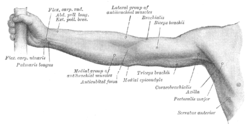| Cubital fossa |
|---|
 |
| Ulnar and radial arteries. Deep view. |
|
| Latin |
fossa cubitalis |
|
|
|
|
|
|
|
|
|
|
The cubital fossa or elbow pit[1] is the triangular area on the anterior view of the elbow of a human or other hominid animal. It is also called the antecubital fossa because it lies anteriorly to the elbow (Latin cubitus) when in standard anatomical position.
Boundaries
- superior (proximal) boundary — an imaginary horizontal line connecting the medial epicondyle of the humerus to the lateral epicondyle of the humerus
- medial (ulnar) boundary — lateral border of Pronator Teres muscle originating from the medial epicondyle of the humerus.
- lateral (radial) boundary — medial border of Brachioradialis muscle[2] originating from the lateral supraepicondylar ridge of the humerus.
- apex- it is directed inferiorly, and is formed by the meeting point of the lateral and medial boundaries
- superficial boundary (roof)- skin, superficial fascia containing the median cubital vein, the lateral cutaneous nerve of the forearm and the medial cutaneous nerve of the forearm, deep fascia reinforced by the bicipital aponeurosis (a sheet of tendon-like material that arises from the tendon of the biceps brachii)
- deep boundary (floor)- brachialis and supinator muscles
Contents
The cubital fossa contains four main vertical structures (from lateral to medial):
The ulnar nerve is also in the area, but is not in the cubital fossa; it occupies a groove on the posterior aspect of the medial epicondyle of the humerus.
Several veins are also in the area (for example, the median cubital vein, cephalic vein, and basilic vein) but these are usually considered superficial to the cubital fossa, and not part of its contents.
Clinical aspects
During blood pressure measurements, the stethoscope is placed over the brachial artery in the cubital fossa. The artery usually runs medial to the bicepital tendon. The brachial pulse may be palpated in the cubital fossa also just medial to the tendon.
The area just superficial to the cubital fossa is often used for venous access (phlebotomy). A number of superficial veins can cross this region. It may also be used for the insertion of a peripherally inserted central catheter.
Historically, when (venous) blood-letting was practiced, the bicipital aponeurosis (the ceiling of the cubital fossa) was known as the "grace of God" tendon because it protected the more important contents of the fossa (i.e. the brachial artery and the median nerve).
Additional images
| Superficial veins of the upper limb. |
| Front of right upper extremity. |
| Front of right upper extremity, showing surface markings for bones, arteries, and nerves. |
|
See also
References
External links
|
|---|
| | Upper limb | |
|---|
| | Lower limb | |
|---|
|
General anatomy: systems and organs, regional anatomy, planes and lines, superficial axial anatomy, superficial anatomy of limbs |
|




